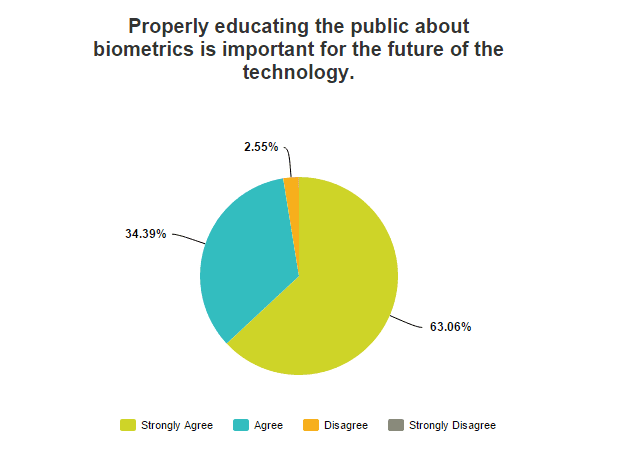December marks the 13th annual FindBiometrics Year in Review—a look back on the year that was with the help from you, our informed readers. Last week we kicked things off with a look at the most interesting areas of application in biometrics and identity management, confirming that FinTech and mobility were the dominant subjects of 2015.
Today, we are turning our attention to a major priority in the industry moving forward: the education of the public on the topic of biometrics.
Education Makes it Happen
As biometrics continue to enter the consumer-facing sectors, they are coming up against friction from the public. The resistance is compounded by misinformation and common misconceptions about digital identity technology, and in many situations experts have pointed to greater education on the topic as an answer to this obstacle.
We asked our survey-takers how strongly they agree with the following statement:

The results are strongly in favor of properly educating the public about biometrics. This was one of the few survey sections that received zero responses in the “strongly disagree” category, and only 2.55 percent of respondents disagree at all. The overwhelming majority of respondents agree: the future of biometrics technology will benefit from a better educated public.
Throughout 2015 we have seen great leaps and bounds in terms of biometric tech being accepted by consumers and the public. Still, there has been a great deal of resistance and controversy surrounding specific deployments and biometric applications, particularly in the areas of law enforcement and marketing.
Early in the year, in the wake of a privacy scandal in the UK, the IBIA released a statement regarding the “the important and legitimate use of facial recognition biometrics in law enforcement deployments,” meant to clarify how the technology ought to be used and what it is currently capable of. The post on their website cites public understanding as key to security efforts involving biometric identification:
“The public understanding of facial recognition is still largely nascent. To betray public trust through practices such as this can be harmful to legitimate efforts to use biometric technology to protect society against criminals and terrorists.”
On a less dramatic note, there is still a long way to go in terms of the general media’s understanding of biometrics. Consistent confusion between certain emerging consumer modalities—like iris and retina or voice and speech—muddies the discourse around what the technology does at a basic level. Common confusion between speech recognition and voice recognition, for instance, inappropriately conflates user interface technology with authentication technology, which while complementary are two very different things. Furthermore, 2015 saw its share of anti-biometrics sentiment, much of which was stoked by the persistent referencing of the problem of irrevocability—the claim that once biometric data is copied, a user’s actual biological trait remains compromised forever.
While the popularity of fingerprint, face, voice and speech biometrics on consumer devices is doing a lot for public perception in terms of the benefits of authentication, it is clear from these results that the industry needs to place a priority on transparency and education for the good of the strong identity based markets. Looking ahead to 2016, it will be interesting to see how the global identity industry rises to this challenge.
—
December 8, 2015 – by Peter B. Counter


Follow Us